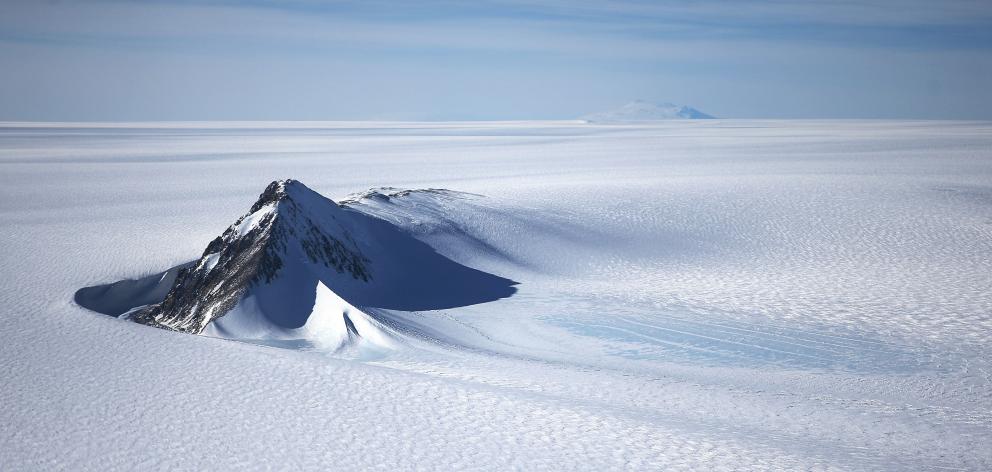
Climate change is taking us into uncharted territory, Prof Jim Flynn argues in a new book. It’s time to plot a course, he tells Tom McKinlay.
Robot ships sail the globe pumping sea spray into the air in a last-ditch attempt to head off disastrous climate change. Science fiction for some far distance future? Not if Dunedin academic Jim Flynn has anything to do with it. Try three year’s time.
The sea spray process, described as our best hope in Prof Flynn’s new book on facing up to global warming, has been developed by engineer Prof Stephen Salter, of Edinburgh University.
• Why geoengineering might be required
"A fleet of 1500 unmanned ships would drag turbines through the water to create sea spray," Flynn writes in No Place to Hide, Climate Change: A short introduction for New Zealanders.
"The spray would be pumped through micro-nozzles some 25 metres into the air as a sort of vaporised salt. At or above that height, turbulence would mix it into the clouds."
It would then brighten the clouds, reflecting more solar radiation back out into space, cooling the Earth, and creating time for humanity to cut emissions to safe levels and develop clean energy systems.
Without that sort of ‘‘geoengineering’’, we’re sunk, or at least our coastlines are, Prof Flynn says.
Given the inadequacy of the carbon-cutting commitments made last year in Paris, and now the climate disaster of a science-denying Republican president-elect in the US, efforts to decarbonise the world’s economies will not happen fast enough to prevent disastrous warming, he argues.

The book is Prof Flynn’s first significant foray into climate science, written as a result of his efforts to educate himself on the topic, and as he has done before, when assailing areas beyond his recognised area of expertise, he’s wound up in somewhat maverick territory. This is the philosophy professor who marched into the field of psychology and became internationally renown for discovering the "Flynn effect", which explains increases in IQ over generations. And that’s not to mention his increasingly prominent role as an arbiter of literature, through his Torchlight List series.
But he’s taking on a bigger argument this time in championing geoengineering, or climate engineering. It is an area of fierce debate.
In his 2013 book Earth Masters, Australian academic Clive Hamilton called it ‘‘playing God with the climate’’ and drew connections between prominent geoengineering advocates and the men who developed the Cold War nuclear arsenal in the US and worked on its Star Wars defence project. Fired by hubris, and supported by the fossil fuel lobby and conservative think tanks, these men see the world’s environmental problems as another engineering challenge, according to Prof Hamilton.
Further, the public ethics professor says little is known about the potential impacts of climate engineering.
"Almost nothing is known about how long-term spraying of ocean tracts would interact with global climate patterns such as continental warming, ice-sheet melt and methane release," Hamilton wrote of Salter’s proposition.
Responding by email this week, Prof Hamilton says his views on geoengineering have not changed "although my level of alarm about rising global emissions has escalated".
"Without detailed studies, marine cloud brightening using Salter’s ships seems to be the least risky form of planetary-scale geoengineering," he concedes, "but none of the political, strategic and ethical dilemmas it poses have been considered."
• All sorts of questions would need to be settled before it could get under way: Who should deploy this climate-altering technology and control it? What if marine cloud brightening is good for the United States but not so good for Africa?
"These questions must be answered before humans attempt to take control of the world’s climate system," Prof Hamilton says.
That’s fine, says Prof Flynn, but the time for caution is past, noting the increasing alarm expressed by the likes of Nasa scientist and leading climate scientist James Hansen at the plodding pace of global climate action.
"It is a desperation strategy but these are desperate times."
Even before Donald J. Trump’s triumph, the world was on track for 3degC or 4degC of warming by the century’s end, Prof Flynn says, the sort of figure that would bring several metres of sea-level rise and could trigger runaway climate change. Indeed, Hansen says the latter could happen at 2degC. The Nasa man suffered a further setback in the US polls last week, watching a carbon tax proposed for Washington State defeated in an election day referendum there.
And anyway, we’re indulging in geoengineering right now, Prof Flynn says. All that CO2 building in the atmosphere is changing the patterns of wind, rain and warming as we speak, to say nothing of acidifying the oceans.
The widespread aversion to climate engineering among those alarmed by climate change means they too, along with climate sceptics, are in denial, Prof Flynn writes in his book. Their delusion is that "there is some hope we can persuade nations to cut their carbon emissions". That ignores political reality, as elected leaders will not curb economic growth if it means they’ll lose power.
In typical Flynn style, his book starts from first principles and builds an edifice of welded logic on which to hang his conclusions. There’s a quick march through climate history, including an explanation of how our polar caps are currently the perfect size to keep the Earth in a climate sweet spot, as they have done since the Wurm Glaciation, or ice age, that ended 12,000 years ago; a beginner’s guide to clean green fusion energy; and a summary of the various other approaches to turning down the thermostat.
As much as anything, Prof Flynn is seized by the speed with which we are melting the world’s glaciers. Polar ice loss quickened in the 2015-16 year to 4000 gigatonnes, a trend that would push cumulative losses to 4,800,000 gigatonnes by 2110, he writes. The resulting loss of albedo effect, the solar radiation reflected back into space by glacial ice, will only speed further warming.
"You can’t rebuild those damn glaciers once they start going," Prof Flynn said this week in an interview.
"The Thwaites Glacier is probably going to break off."
The Thwaites is the stopper in the bottle that holds the West Antarctic ice sheet in place. Once it is exposed, sea level rise is a runaway train. Forget St Kilda.
"You are going to have to float that stadium on pontoons up to Prospect Park," Prof Flynn says with a chuckle.
"It is not going to stay where it is."
Time then, to launch Salter’s armada, under the auspices of a UN subcommittee, even if it’s on a relatively modest scale initially.
"You might get 30 vessels on as an experimental thing," Prof Flynn says. "Just to iron out all of the inevitable hitches and glitches. No-one I think could object to that."
That would be doable within three years, apparently, at less than $US100 million.
Once the full complement of 1500 ships were on the job, they’d send up just 1% more ocean spray than at present, doing just enough cloud brightening and reflecting just enough solar radiation to stabilise the system.
Starting now would mean the project could be well advanced in a decade’s time, when pessimism about the chances of rescuing the world’s climate might otherwise be testing new lows, Prof Flynn says. It would mean we had a fall-back position.
Yes, everyone would need to be reassured that the sea spray would not affect traditional patterns of rainfall, but Prof Salter is confident that won’t happen, and in fact holds out the prospect that by using guidance satellites you could selectively increase rainfall where it is needed.
There is at least one further difficulty to overcome.
"I’m in touch with Salter and he doesn’t have any money yet, and I said ‘to hell with that, we have to get you some money’. So I am not going to let it drop," Prof Flynn declares.
He has already begun to take his approach to the world, speaking in Italy, where he urged the mayors of the Adriatic coast to take up the cause. The book was published in Italy first, and has sold 1000 copies.
Russia is another potential ally, Prof Flynn says, having already mooted at UN forums that geoengineering be part of the climate change response.
Indeed, the Intergovernmental Panel on Climate Change included geoengineering in its 2014 assessment report for the first time.
New Zealand should join the push, Prof Flynn says.
"If no-one else is going to see the Minister for the Environment in New Zealand, I am going to."
Line the Russians and Italians up alongside and Salter’s ships might get serious discussion.
Prof Flynn gives every appearance of having a remarkably undimmed faith in reason and argument, in this the "post-truth" world of Brexiters and Trump boosters.
If the case for Salter’s ships can only be made to the right people, the cogent opinion makers and shapers, it could yet set sail, he says.
"As Eric Fromme said: ‘Truth is a powerless man’s only weapon’," Prof Flynn offers.
"We have to bet on truth however unlikely a horse it may seem."
It may just be time to bet the ranch.
Reshaping the century: Prof Jim Flynn’s prescription
1. We get Prof Stephen Salter’s sea-spray ships on the water and lower current temperatures by 1degC: we will know we have enough ships when the polar glaciers stop melting.
2. If we get temperatures to that level, and do so no later than 2035 or 2040, we may avoid the point of no return.
3. If we make dramatic progress towards clean power production between 2065 and 2100, we can continue economic growth and hope to reduce emissions to zero.
4. In the meantime, emissions will continue to build up in the atmosphere and CO2 will make our oceans more acidic, therefore we must do all we can to cut emissions and hold increases to a minimum.
5. If economic growth continues, Africa may become prosperous enough to join the rest of the world in its reproductive patterns, and the world’s population really will level off at 11 billion.
6. The persistence of CO2 in the atmosphere means the level will drop from its peak only gradually, but if we reach zero emissions in 2100, the day may arrive when we can do something else with the sea-spray ships.












